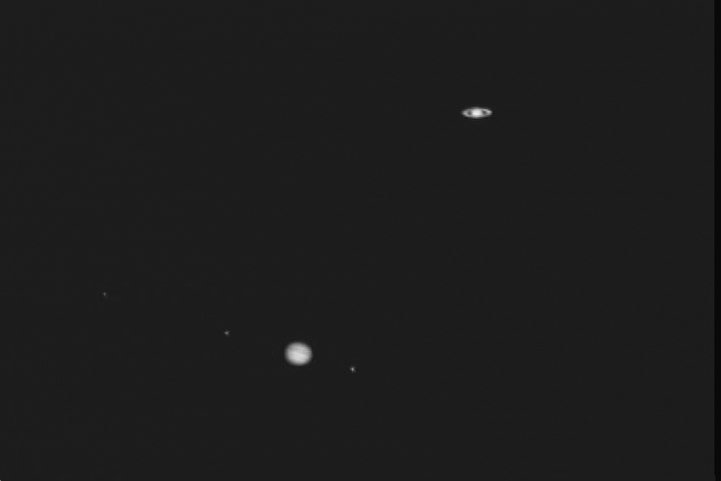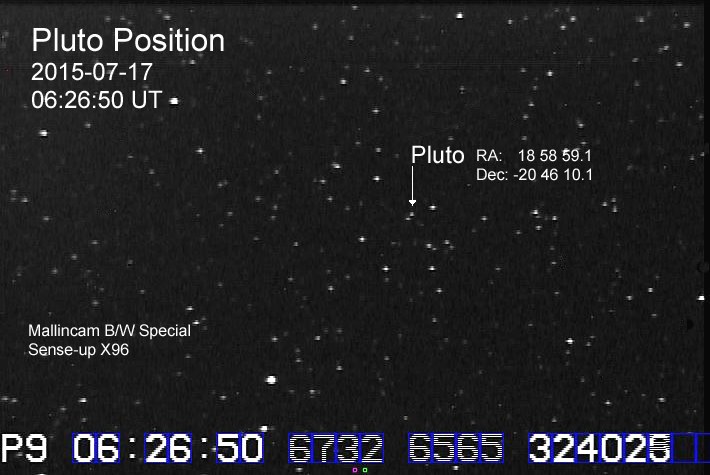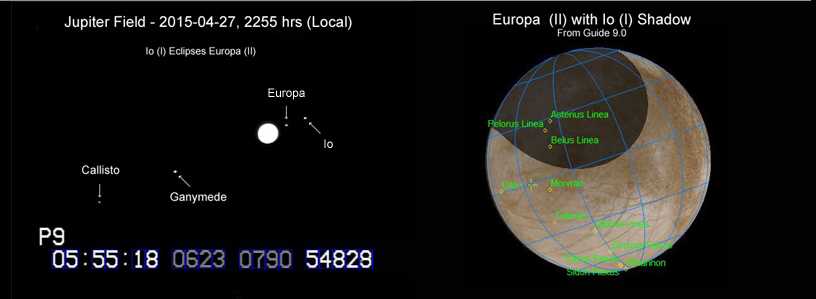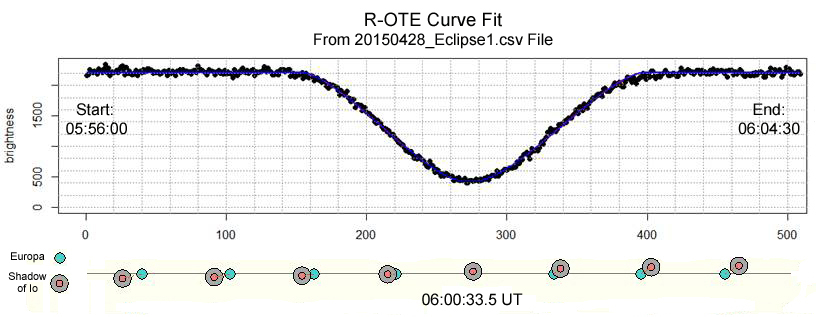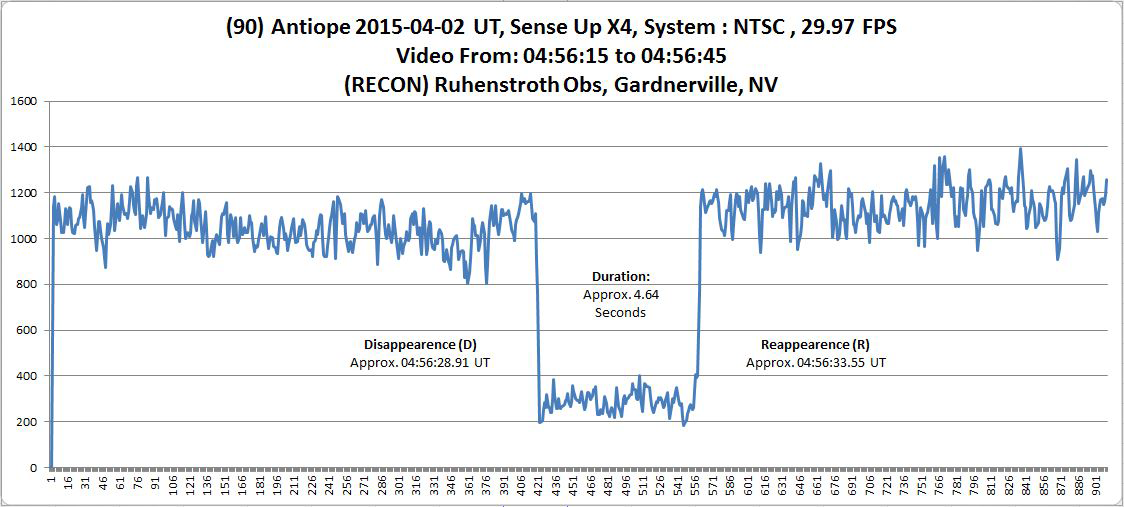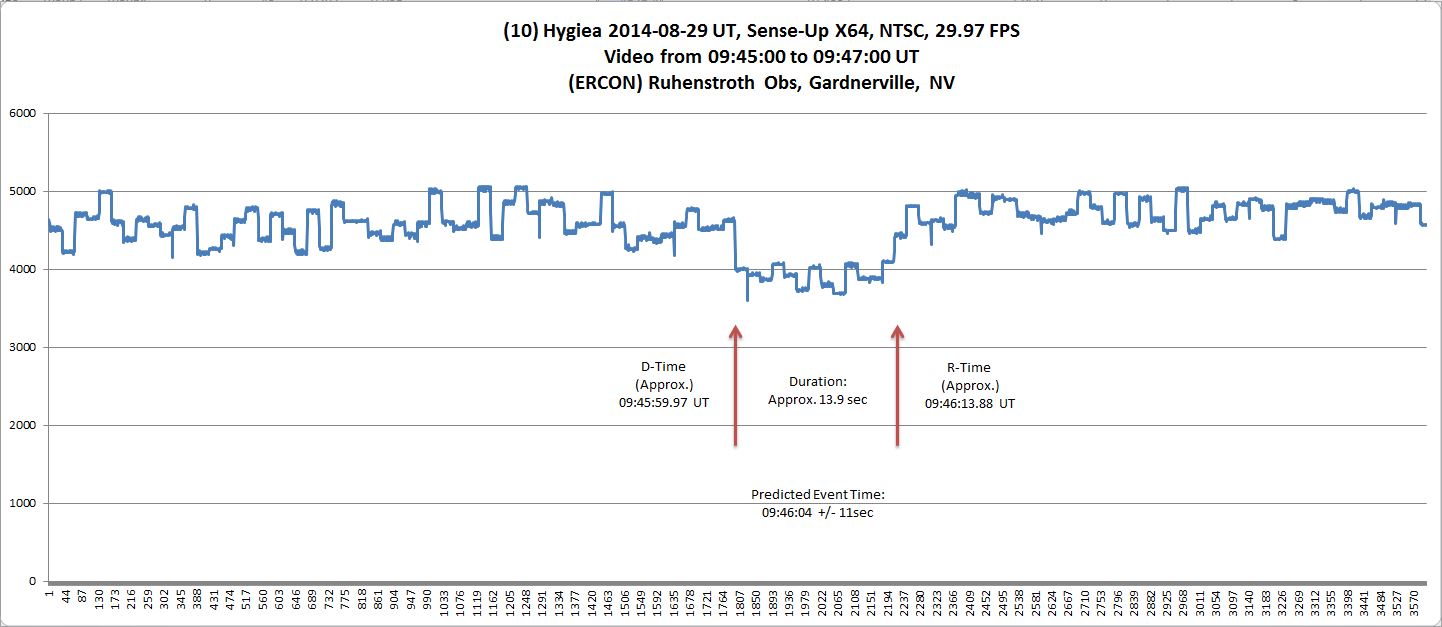As a follow-up to John’s posting of the Jupiter-Saturn conjunction, I thought I would post the below image. This is a composite image of the individual planets from a number of videos taken that evening. The videos were taken very early after sundown to take advantage of the elevation of the planetary conjunction and the somewhat better seeing that provided. The telescope was a polar mounted 12” Meade LX200GPS with a 3.3 focal reducer using a Watec 910 HX black and white camera. Each short video was made with an exposure appropriate for the planet as Jupiter is significantly brighter than Saturn. A slightly longer exposure was also taken to get the three moons of Jupiter. The better image of each planet from the videos was then cut and pasted into this 720 by 480 composite. The relative positions of the planets is somewhat different than John’s Stellarium rendition, as in this one north is up.
Author Archives: Jerry Bardecker
Asteroid 45 Eugenia
An Interesting Main Belt Asteroid and Recent Occultation Observation
From Wikipedia: “Eugenia was discovered on 27 June 1857 by the Franco-German amateur astronomer Hermann Goldschmidt. His instrument of discovery was a 4-inch aperture telescope located in his sixth floor apartment in the Latin Quarter of Paris. It was the forty-fifth minor planet to be discovered. The preliminary orbital elements were computed by Wilhelm Forster in Berlin, based on three observations in July, 1857.
Eugenia is a large asteroid, with a diameter of 214 km. It is an F-type asteroid, which means that it is very dark in coloring (darker than soot) with a carbonaceous composition. Like Mathilde, its density appears to be unusually low, indicating that it may be a loosely packed rubble pile, not a monolithic object.”
In 1998 astronomers discovered that Eugenia had a moon. It was the first discovery of a moon orbiting an asteroid by a ground based telescope. The discoverers name the moon Petit-Prince. The moon, about 13 km in diameter, orbits Eugenia in about 5 days. Discovered in 2004 a smaller moon, at about 6 km, orbits Eugenia every 4.7 days and is designated S/2004 (45) 1.
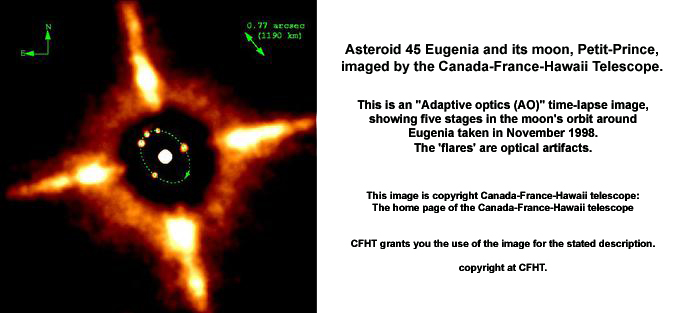
Earlier this month, 45 Eugenia was predicted to occult an 11.8 magnitude star (UCAC4-369-175949) in the constellation Sagittarius. The maximum duration of the event was predicted to be 20.6 seconds with a magnitude drop of 0.4 – 0.5. The predicted path extended from central Montana, through Idaho, northern Nevada and northern California. An announcement of the event was distributed to observers across the west in an attempt to perhaps observe the known moon, Petit-Prince.
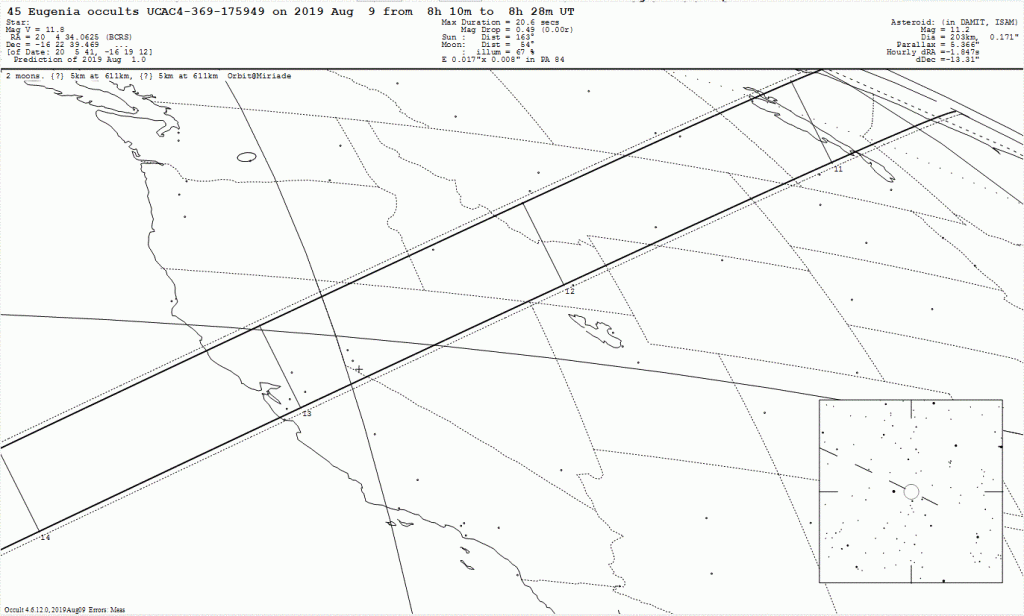
Predicted event time was approximately 08:12:45 +/- 2 sec UT (01:12:45 PDT). There have been a number of previous occultation events by Eugenia over the years, with 13 positive chords recorded in 2014 and 7 positive chords in 2017.
Because of its size, Eugenia is a fairly bright object at mag 11.2 and is easily discernible from the target star as seen on the two images below. These images were extracted from integrated video taken as the asteroid approached the target star and after the predicted event. Time stamp data for each of the images is shown at the bottom of each frame.
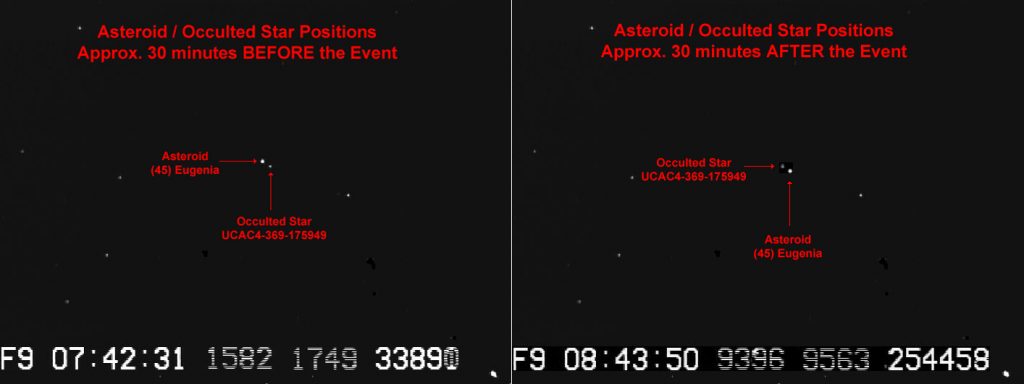
I was able to record the event with a 304 mm SCT equipped with a 3.3 focal reducer, WAT910 HX B/W video camera and IOTA-VTI time stamp inserter. Video was recorded with no integration at 2X. Light curve data and occultation event timing extraction was completed using a new set of programs authored by Bob Anderson in conjunction with the North American International Occultation Timing Association (IOTA).
The recently released PyMovie is available at: http://occultations.org/observing/software/pymovie/.
PyOTE is available on the IOTA web page at: http://www.asteroidoccultation.com/observations/NA/.
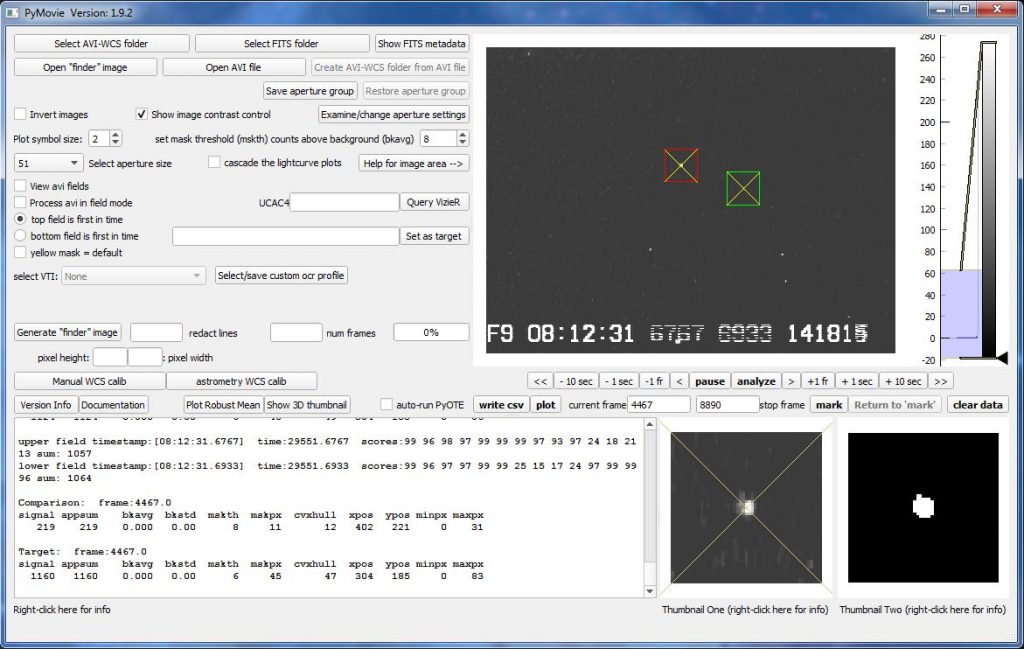
At my observing location in Gardnerville, Nevada I observed an occultation event with duration of 19.1 seconds (starting at 08:12:43.489 and ending at 08:13:02.574 UT). Calculated mag drop was 0.44.
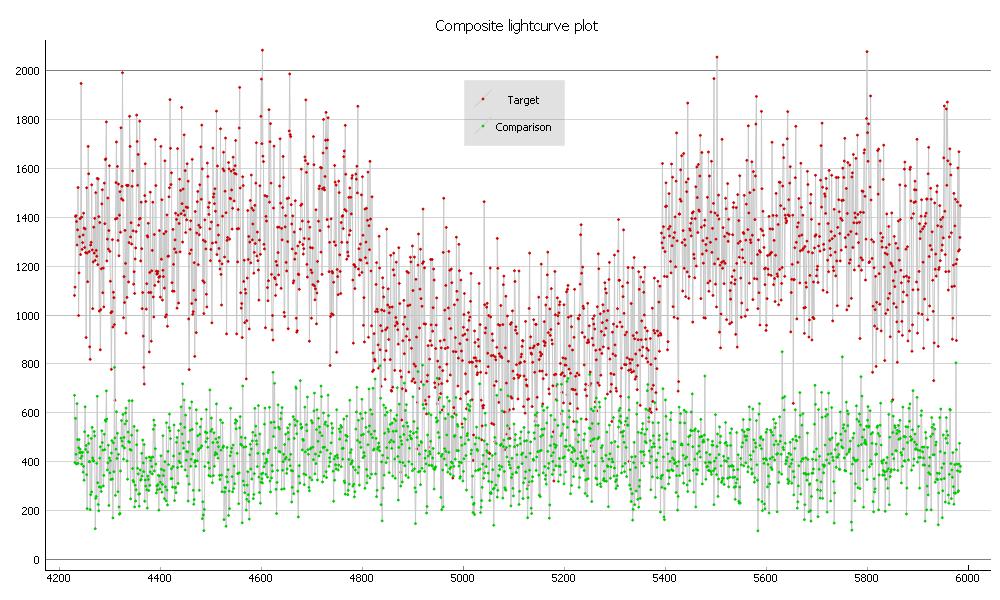
Unfortunately, of the six other observers that had planned to also participate, all were clouded out of the event.
Feb. 9th – Successfully Observing Both (191) Kolga AND (154) Bertha
On February 3rd the RECON projects leads announced an optional observing event for asteroid (191) Kolga for the evening of Feb. 9th. The specifics of this event was also noted on Occult Watcher (OW) which provided many of the event details, like potential observing station information, path maps, data on the occulting asteroid and target star, etc. What many may not know, is that on the evening of Feb 9th, another event involving asteroid (154) Bertha was also predicted to occur approx. 17 minutes later then Kolga, over much of northern California and northern Nevada. The prediction paths for these two events crossed some 40-50 km northeast of Reno, Nevada. For my typical observing station in Gardnerville Nevada, I was NOT in the predicted path of either of these events, (although inside 1 sigma for the Bertha event). After some evaluation of the events and the possibility of observing positives for both, I decided to “go mobile” with an 8” SCT and attempt observing both events from a location near Lahonton State Recreation Area, which is northeast of Carson City (approx. 56 km). For this location OW predicted that I had a 78% positive observing probability for Kolga and a 98% probability for Bertha. The LiMovie generated light curves for these observations are below.
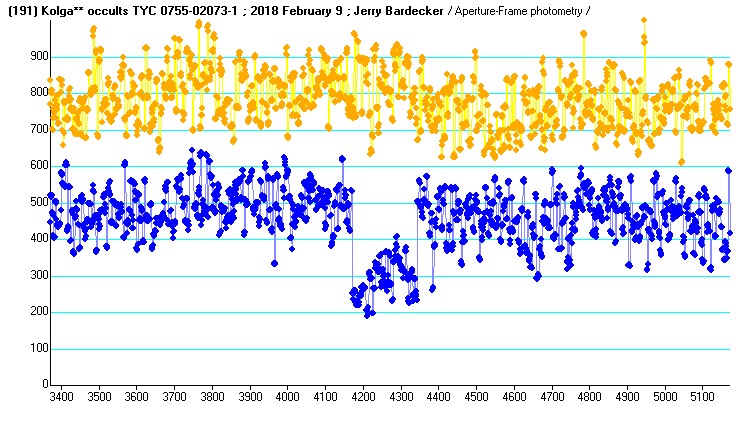
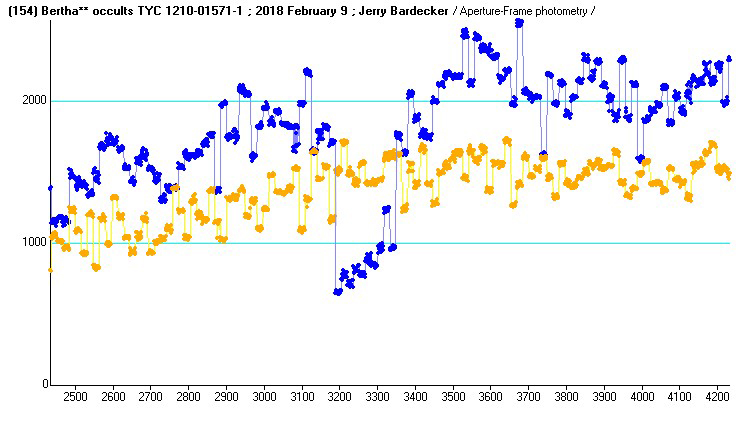
As can be seen, I was fortunate enough to record occultation events for both Kolga and Bertha. For Kolga the duration was 5.74 seconds and for Bertha 5.34 seconds. It is a rare opportunity that two events are predicted for the same evening so close in time and so close together, location wise. For me, it was even more surprising that, none of other potential obstacles to making these observations (travel, weather, setup, etc.), got in the way of a successful evening.
Lunar Eclipse Over Western Nevada
For those of you that weren’t able to view the early morning event, forgot about it, or maybe just didn’t care, I offer the attached composite image as seen from Gardnerville, Nevada. The lunar eclipse started around 11:48 UTC (03:48 PST) and the moon was completely within the earth’s shadow about an hour later. We had partly cloudy skies with varying levels of cirrus over the Carson Valley. The moon was approximately 36 degree above the western horizon at the start and set before coming completely out of the earth’s shadow. For those interested in the specifics of the captured images; each of the three images in the composite were taken with a Canon EOS 80D with a Tamron 150-600 mm G2 zoom at 600mm (APS-C sensor – 1.6 crop factor – 960mm equivalent focal length). Exposures for each of the images are: 1/500 sec. (left image), 1.6 sec. (middle image) and 4 sec. (right image) at f/6.3. The camera and lens system were mounted on an EQ mount for the last images due to the necessary length of exposure.
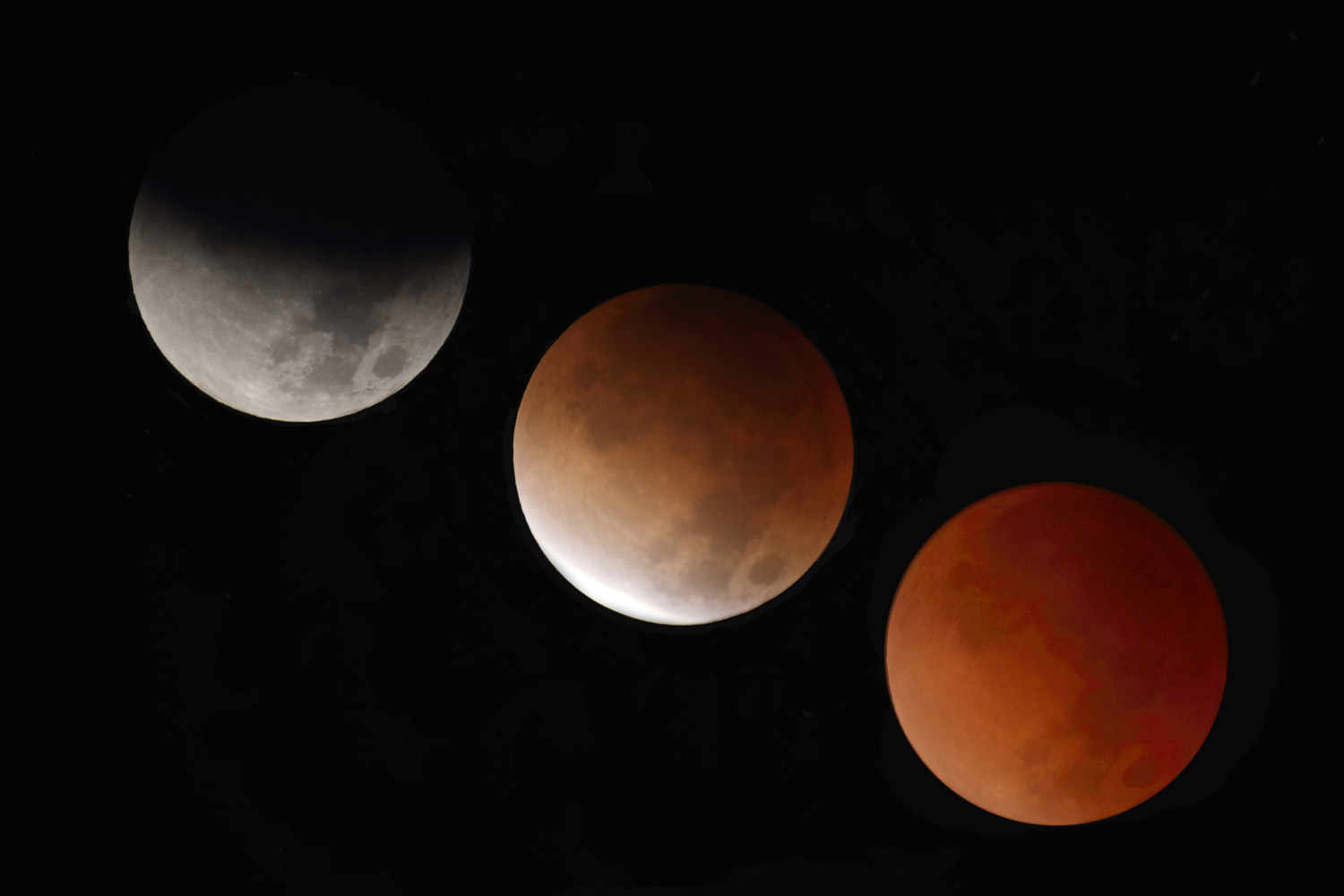
Total Solar Eclipse 2017 in Oregon
Just now starting to work on processing of images from our group TSE adventure near Shaniko, OR. Wanted to share at least one image I was able to capture.
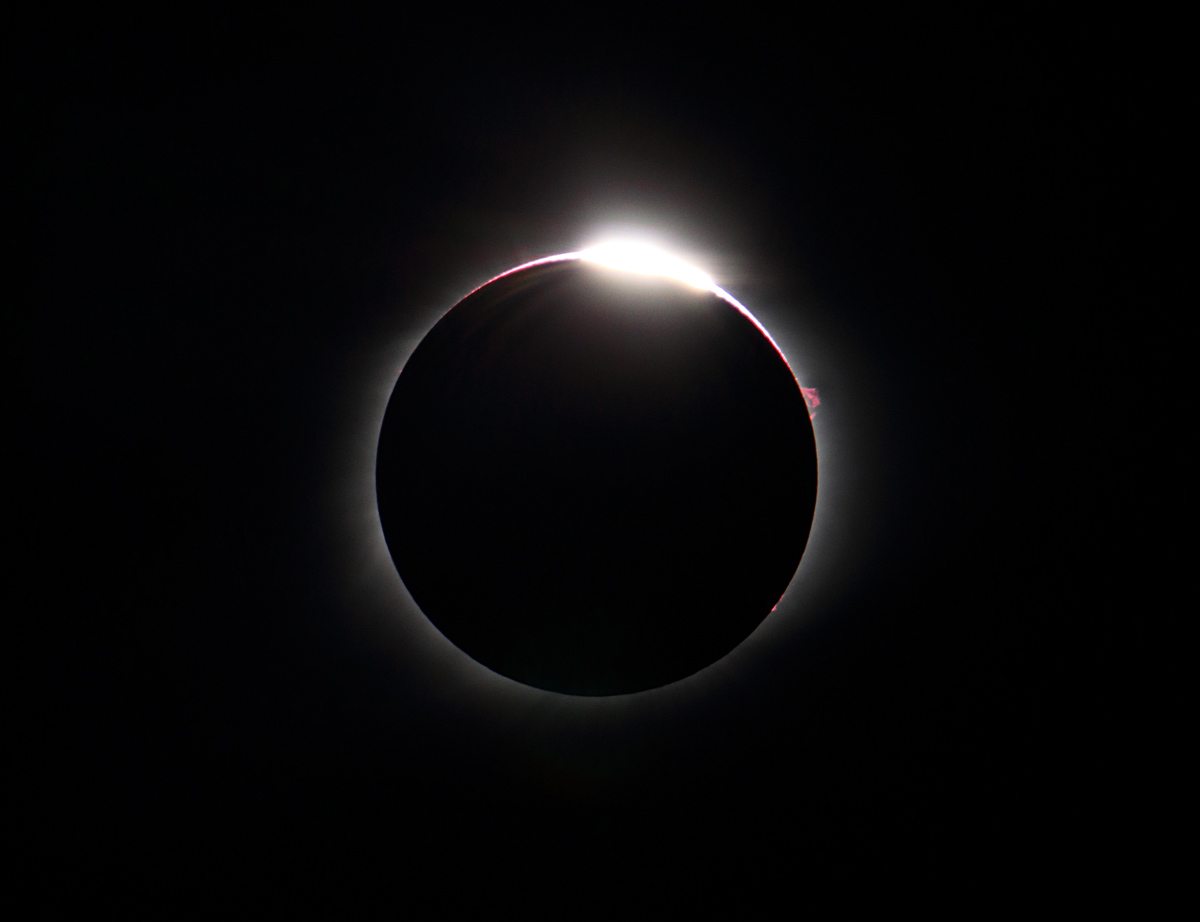
Results for (441) Bathilde occults TYC 0627-00444-1
This was the last event for February posted by Tony George. The event ocurred early evening on Feb 25 at around 7:38 PM (PST). Predicted event time was 03:38:34 UT February 26th. The target star (11.6 mag.) for the occultation was low in the west at 27 deg altitude and in the constellation Pisces. The predicted maximum duration was 1.6 seconds at the predicted centerline. On the Occult Watcher prediction map my location was just outside (2 km) on the south side of the shadow path in the 1 sigma zone. I had previously contacted Red Sumner at the Jack C. Davis Observatory to see if he could possibly observe. The observatory was only a few kilometers off the predicted centerline. Although partly cloudy most of the afternoon, the clouds started to clear by early evening and there appeared to be a good chance for an observations. Scope setup went quickly, but just before event time a small patch of cirrus moved over the field stars. I set the camera integration to 8X and the VirtualDub timer program to record for 5 minutes centered around the predicted time. Then it was just to hope for the best. Sure enough, the clouds cleared and almost exactly at the predicted time I observed a short ‘wink’ of the target star. A follow-up analysis by LiMovie confirmed an approx. 1.7 second occultaion event. Tony George was gracious enough to provide a formal R-OTE analysis as seen below.

The actual camera and VTI corrected duration was 1.670320 seconds. This event turned out to be one that could have been observed by as many as three RECON sites (Gardnerville, Yerington, and perhaps Hawthorne). It appears though that, as of this writing, I was the only positive observer. A formal report was filed with the IOTA using the OW IOTA Reporting plug-in which uses a simple Excel spreadsheet format.
Reported IOTA occultation results for all of North America can be viewed at : http://www.asteroidoccultation.com/observations/Results/
You Too Can See Pluto !
Jupiter Mutual Event – Io Eclipses Europa – April 27, 2015
As Jupiter shines brightly during its 2014–2015 apparition, quite often Jupiter’s four big Galilean moons will occult and cast their shadows on each other. A “mutual events season” like this happens about every 6 years, when Earth and Sun cross the plane of the satellites’ orbits. We are now in the later part of this season, with these mutual events, still occurring thru August. Some of these events will dim the shadow-eclipsed moon, as seen here, or the combined light of two moons during a partial or total occultation. Photometric recordings of the events provide a very accurate way to refine the satellites’ gradually changing orbits. Their orbits are morphing in interesting long-term ways due to interactions among the satellites and between them and Jupiter. Occult Watcher can obtain mutual events through the “Planet Satellites (Global)” feed under “Configuration / Prediction Feeds”.
The event illustrated above occurred on April 27 at 2300 hrs, PDT. The shadow from the Jovian moon Io was cast upon the surface of Europa as viewed from earth. The accompanying light curve shows the apparent drop in brightness during the eclipsing event. The total event was approximately 4 minutes in length out of the nearly ten minutes of recording time.
This particular video was further analyzed by Tony George for accurate timing extraction. Data was then properly format and sent to the IMCCE in Paris for inclusion in this season’s Jovian moons mutual events data set.
A Reminder for RECON Teams: The video recording of these types of events will probably require some Mallincam camera setting changes to properly record a useable video. Teams are reminded that camera setting should be returned to the proper RECON occultation settings before a RECON campaign event.
(90) Antiope Occultation from Gardnerville, Nevada
(10) Hygiea Occults 4UC 574-027283 – August 29, 2014
I know a few others in the RECON community were planning to attempt this event. A major obstacle for many, was the very low elevation of 14 deg. in the east. The fact that the event occurred at around 3 a.m., probably discouraged a few other potential observers. For me, those challenges, and a few more, were also very real. An interesting aspect of this event as noted on Steve Preston’s info page, was that the target star was one component of a relatively close double star (5 arc seconds separation, 12.6 and 13.8 mag). This factor was really only significant when attempting to analyze the event with LiMovie and subsequently by Occular and/or R-OTE for timing calculations. As you can see from the light curve, the event was indicated by a very low magnitude drop. The predicted mag drop was 0.5, but this was calculated for only the one component of the double system that was occulted. At the focal length used to make the recording the three components (asteroid and two stars that make up the double) cannot be separated in the aperture ring of LiMovie. Because of the additional star the resulting mag drop was somewhat lower than that predicted. A real added treat would have been if the position angle (PA) of the double system would have been such that both stars would have been occulted by Hygiea. In this case though, Hygiea passed just to the celestial north of the doubles second component. The light curve below represents my estimates of the occultation timings and is not the final IOTA official data.

